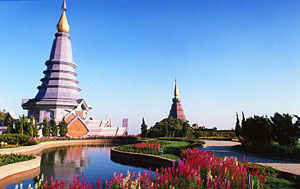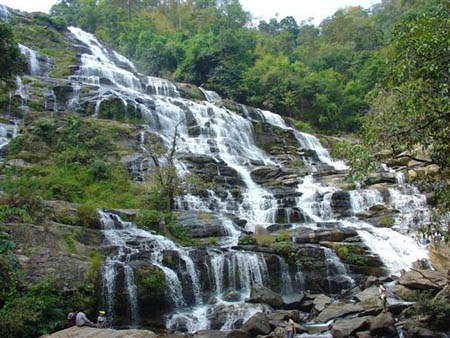Doi Inthanon National Park
The imposing Doi Inthanon, located in Chiang Mai
province, is the highest point in the country, and is often dubbed 'The Roof of
Thailand'. In Doi Inthanon National Park there are also several lesser summits
to explore. Geologically speaking, the mountain range is largely composed of
granite batholiths that extend in a southerly direction towards the Shan Hills
range in Myanmar (Burma), and form the division between the Ping River to the
east and the Mae Chaem River to the west.
The park covers an area of 301,500 rai (482 sq
km), taking in parts of the Son Pa Tong, Jom Tong, and Mae Jam districts. This
mountainous park is also home to one of the most impressive waterfalls in
Thailand, the Mae Ya Waterfall.
In the past Doi Inthanon was known as Doi Loing,
or 'Doi Ang Ka' (Doi meaning mountain). Doi Loing therefore means a big
mountain. The name Doi Ang Ka was sometimes used, as about 300 m away from the
mountain's base there was a pond shaped like a washing tub (Ang). Flocks of
crows (Ka) also used to gather at the pond, and that is how the name came to be
adopted.
But what about the name Doi Inthanon? Chiang
Mai’s last sovereign, King Inthawichayanon, with great foresight, expressed
concern for the forests of the hilly countryside in the north. He was aware
that it served as the watershed for the whole of central Thailand. Before his
death, he commanded that his remains were to be placed on the summit of Doi
Loing. After his demise his wishes were carried out, and the mountain was
renamed 'Doi Inthanon' in honour of his name. The stupa at the summit that
houses his remains is visited by thousands of people every year.
In 1959, the Doi Inthanon Forest was one of
fourteen throughout the country that had been established as National Parks by
the government. And in 1965 it was named as a National Conservation Area. Later
on, in 1972, the park's boundaries were extended by the Forestry Department of
Thailand to include the Ban Loing, Sob Tai, Song Kael, Yang Karm, Jom Tong, Mae
Vin, and Son Pa Tong districts and sub-districts.
On 16th January 1974, during a visit by His
Majesty the King and Her Majesty Queen Sirikit to Doi Kun Klang, he suggested
that the boundaries of the park be further extended. In February the Mae Suank,
Chang Keng, and Ta Pha subdistricts became part of the park. Due to the park
extension projects, in 1975 the Doi Inthanon National Conservation Forest, the
Jom Tong National Conservation Forest, and the Mae Jam National Conservation
Forest all became the Doi Inthanon National Park that we know today.
Phra Mahathat Nopphon Phumisiri
Her Majesty The Queen's chedi, Phra Mahathat
Nopphon Phumisiri, is situated on the summit of Doi Inthanon Mountain in the
Doi Inthanon National Park.
Phra Mahathat Nopphon Phumisiri was erected in
1992 beside His Majesty The King's chedi. It was erected by the Royal Thai Air
force, on behalf of the Thai people, to celebrate Her Majesty's sixtieth
birthday.
 Phra Mahathat Nopphon Phumisiri
Phra Mahathat Nopphon Phumisiri
Mae Klang Waterfall
This waterfall is a very popular picnic place for
local boys and girls and some Chiang Mai and Bangkok families own bungalows on
the river. Rocky paths climb up beside the thirty metre high falls and if you
reach the top there is a fine view. There is a messy huddle of food, drink and
souvenir stalls at the entrance and below the main falls. If you cross over the
bridge you will enter the beautifully laid out gardens of the northern branch
of Wat Chai Monkon, a famous Bangkok temple. In the grounds is a spectacular
chedi containing a lift. There is also an enormous Buddha statue made out of
one piece of Canadian greenstone.
Mae Ya Waterfall
Chiang Mai and the north of Thailand are famous
for their waterfalls, although there are none to compare with Niagara, Kaitur
or Victoria. The highest and one of the most beautiful in Chiang Mai Province
is Mae Ya. Easily accessible just off the road up Doi Inthanon, the water
tumbles down a three hundred-foot cliff in a series of spectacular leaps. At
the bottom is a cool pool where children can swim and also a pleasant picnic
area.
 Mae Ya Waterfall
Mae Ya Waterfall
Vachiratharn Waterfall
Quite a way up Doi Inthanon, Vivacharatarn is
another stunning waterfall with its main attraction being a very tall and
narrow drop sending off wafts of mist in all directions. It is quite a walk
down to the falls and can be slippery in the rainy season. If you follow the
falls downstream and are a bit adventurous, you can come across may secluded
picnic and pool areas where you will be able to enjoy the distant rumbling of
the falls along with a gentle solitude.
There are other waterfalls in Doi Inthanon Park
but these three are the most easily accessible and the most spectacular.
|